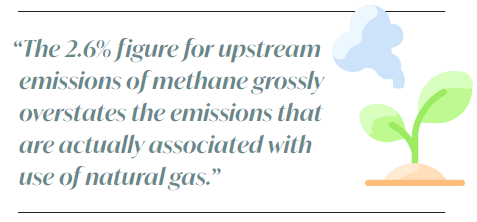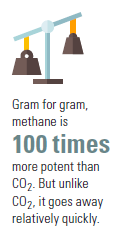Bashing blue hydrogen: false numbers, flawed models [Gas in Transition]
In the August 12, 2021 issue of Energy Science and Engineering, Cornell’s Robert W. Howarth and Stanford’s Mark Z. Jacobson published a paper titled “How Green is Blue Hydrogen?”, in which they claim that the “global warming potential” (GWP) of blue hydrogen (based on natural gas with CCS) is higher than that of coal or natural gas. The paper created quite a stir. News accounts of the claims in the paper have been widely carried.
In the abstract of the paper, the authors, who are known for their advocacy of “100% wind-water-solar” roadmaps, state: “We undertake the first effort in a peer-reviewed paper to examine the lifecycle greenhouse gas emissions of blue hydrogen accounting for emissions of both carbon dioxide and unburned fugitive methane. Far from being low carbon, greenhouse gas emissions from the production of blue hydrogen are quite high, particularly due to the release of fugitive methane.”
|
Advertisement: The National Gas Company of Trinidad and Tobago Limited (NGC) NGC’s HSSE strategy is reflective and supportive of the organisational vision to become a leader in the global energy business. |
However, the numbers and models they use in the paper are deeply flawed. We will look at three assumptions made in the report that can be easily seen to be misleading or incorrect.
First, as has been pointed out by Ted Nordhaus of the Breakthrough Institute, the study employs a 20-year window to assign a greenhouse gas equivalency to methane instead of the 100-year window that the IPCC uses.
Methane has an expected lifetime in the atmosphere of only around 12 years. While it’s present, it is a very potent greenhouse gas. Gram for gram, it’s over 100 times more potent than CO2. But it goes away. Integrating its warming potential over a 20-year window gives it a CO2 equivalency of 86 – the figure that Howarth and Jacobson use in their study. Over a 100-year window, though, it’s only 28. That is one third of the figure that Howarth and Jacobson employ. It’s lower, because over most of that 100 years, the emitted methane will be long gone. Using the 20-year equivalency exaggerates the overall impact of methane emissions.
Fugitive emissions
Secondly, Howarth and Jacobson’s study assumes a figure of 3.5% for the fugitive emissions from all gas production. It’s the adjusted sum of two parts. The first is an estimate of upstream emissions from oil and gas field operations. They put this at 2.6%. The second is an estimate for everything else. They put that at 0.8%. The sum, 3.4%, is then adjusted upward by 0.1% to account for a small difference between net production (excluding upstream leakage) and net consumption. They don’t specify the source of the difference. Presumably it’s from gas consumed in gas processing and pumping operations.
One could get lost in debating whether the 3.5% estimate is too high, too low, or about right. It’s lower than some that one can find and higher than most others. The 2.6% part comes from an unpublished synthesis by Howarth of 20 studies of 10 non-conventional oil and gas basins. It’s based on satellite measurements of methane concentrations, combined with statistical models of winds and gas dispersion in the lower atmosphere around the times of the observations. So let’s assume it’s good, at least for those fields.
All of which, however, is beside the point. Gas emissions from non-conventional fields – shale plays where fracking is required to produce oil and gas – are known to be substantially higher than from conventional fields. The reason? Flaring in non-conventional fields is much higher than in conventional fields. The preponderance of methane leakage will be from flaring. A recent study by the Natural Resources Defense Council (NRDC) found that 11% of flares in the Permian Basin were partially or wholly unlit, emitting large amounts of methane.
The salient point, however, is that virtually all flaring activity, in terms of volume flared, involves associated gas from oil wells. They are wells that, for one reason or another, are not connected to the system for collection and distribution of natural gas. Divorced from that system, they have nothing whatsoever to do with end use applications that consume natural gas.
Wells that do feed into the natural gas system very rarely flare gas. Aside from tiny amounts that are released in maintenance operations, they have no reason to flare. All the gas they produce feeds into the system.
What this means is that the 2.6% figure for upstream emissions of methane grossly overstates the emissions that are actually associated with use of natural gas. If we decline to use natural gas for hydrogen production, it will not reduce those emissions. If we do use it for hydrogen production, it will not increase them.
It could even have the opposite effect. The added demand could raise natural gas prices, providing oil well operators with incentive to connect their wells to the gas infrastructure and stop wasting so much associated gas in unreliable flares. Some estimates suggest flaring accounts for 4% of global gas consumption, making it “low hanging fruit” for simultaneously increasing the supply of natural gas and reducing fugitive emissions.
Capture efficiency
The third problem with the paper is that it uses a naive model for the SMR process and carbon capture that is not what would likely be deployed for production of blue hydrogen. The study assumes, among other things, a capture efficiency of just 65% for production of blue hydrogen from natural gas. That’s unreasonably low – a 95% capture efficiency is feasible. It would result in one seventh the carbon emissions.
Technical aspects of blue hydrogen production, whether by steam methane reforming (SMR) or other methods, are the domain of chemical process engineers. Neither Howarth nor Jacobson are chemical process engineers. Howarth lists himself as a “biogeochemist”, while Jacobson is a professor of civil engineering. They are credentialed and affiliated with respected universities. But they either have a limited understanding of reforming processes and efficient ways to capture CO2, or they have deliberately chosen to employ a naive model for their study. The model they use is highly sub-optimal for production of blue hydrogen.
For gray hydrogen, the authors, citing an IEEE article from 2004, state that it takes between 2.0 and 2.5 kWh to drive the production of 1 m3 of hydrogen. That range is realistic for a lot of SMR plants built over the years. Most are associated with oil refinery operations or large fertilizer or petrochemical plants. In that environment, it’s expedient to burn additional feed gas with air in a furnace to supply heat to the reaction tubes in which the SMR reaction takes place. It’s not the most energy-efficient way to produce hydrogen, but it’s relatively cheap and does the job. If one is not concerned about carbon emissions, it’s an appropriate and well-proven design.
If one is concerned about carbon emissions, then burning additional feed gas with air is a poor choice. It gives rise to the need to separate CO2 from nitrogen in the flue gas. A better choice is oxy-combustion, in which the extra feed gas is burned in a mix of recycled CO2 and oxygen. The “flue gas” is then a nearly pure CO2 stream. No costly separation step is needed, and capture efficiency is 100%. Of course, a supply of nearly pure oxygen is needed. That’s not particularly hard to arrange. If the reformer is part of an ammonia fertilizer plant, then there will already be a large cryogenic air separation unit (ASU) within the facility. It’s to provide nitrogen for making ammonia, but it also produces a “waste” stream of nearly pure oxygen. Another option is to marry blue and green hydrogen production systems. Electrolysis of water for one unit of green hydrogen provides enough “waste” oxygen for about three units of blue.
SMR adapted for oxy-combustion and capture of nearly all CO2 emissions is an existing technology. It’s been commercially implemented for supplying CO2 to conventional oil fields in the Permian basin for enhanced oil recovery (EOR). But there are other candidate technologies that would be even better. (See box)
Going forward
Fortunately, Howarth & Jacobson’s paper did receive some pushback from well-known experts. Michael Liebreich, founder of think tank Bloomberg New Energy Finance, tweeted: “If you make implausible assumptions, you get implausible results.”
We need clean hydrogen, for a variety of reasons. Eventually, we will have to pay the energy price to extract it from water. With or without CCS, we won’t be able to rely on cheap reforming of energy-rich hydrocarbons indefinitely. But until we actually reach a 100% clean energy economy, truly green hydrogen can only be produced by clean energy at times when there is no competing use. For now and for a decade or more to come, those times will not occur often enough to make green hydrogen economically competitive. We need a practical way to clear a path for the hydrogen economy. That means we need blue hydrogen.
How to do blue hydrogen: here are some of the technology optionsIt’s important to note that when production of blue hydrogen begins to ramp seriously upward, we won’t be seeing CCS simply tacked on to existing SMR plants. The market will be large enough to justify new plant designs, specifically optimised for the production of blue hydrogen. They will be designed by professionals who truly know what they’re doing, to leverage cheap renewable energy and to minimise consumption of natural gas. Energy to drive the basic reforming reaction might be supplied by clean electricity or by concentrated solar thermal energy, so that the hydrogen output has a greater free energy for heat generation than the hydrocarbon feedstock from which the hydrogen was made. That would certainly confound suggestions that blue hydrogen would be dirtier than using natural gas directly. I don’t know what the winning design for a blue hydrogen production plant will ultimately be. A very strong candidate, however, is described in a May 2019 report published in Science. It’s electrified methane reforming. In that process, the energy to drive the reforming reaction comes from ohmic heating from electrical currents in SMR reaction tubes. There are many potential advantages. One is that no feed gas whatsoever is consumed to provide the heat. There is no flue gas, and no CO2 needing to be captured from it. If the electrical energy for electrified methane reforming comes from clean energy resources, the product can be considered a form of green hydrogen. But by my own rough calculations, the hydrogen yield, per kWh of electricity input, would be about 6 times higher than for electrolysis of water. This could provide an interesting resolution to the ongoing blue vs green hydrogen debates. Combine them, and enjoy the best of both worlds. Electrified methane reforming is by no means the only advanced process that has been implemented or is under investigation. There are many more options. One example is an approach proposed by Norwegian technology firm GTI that employs fluidised calcium oxide to capture and remove CO2 from the downstream water shift reactor of an SMR plant. CO2 removal shifts the reaction equilibrium toward more complete hydrogen conversion and minimises the concentration of CO in the product stream. |
About the author
Roger Arnold is a former physicist, aerospace engineer, and systems architect. He has worked at IBM, Boeing Aerospace, AT&T, and a number of electronics companies and startups in San Diego and Silicon Valley. Now retired, he pursues independent research and writing. His writings focus on climate, clean energy, and sustainability. He is especially interested in exploring how technologies interact and create opportunities for synergistic solutions to critical problems.
This is article was first published in Gas in Transition, Volume 1, Issue 6. You can download your complimentary copy below:




